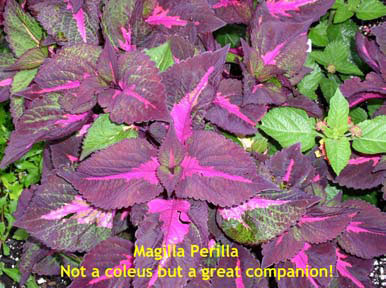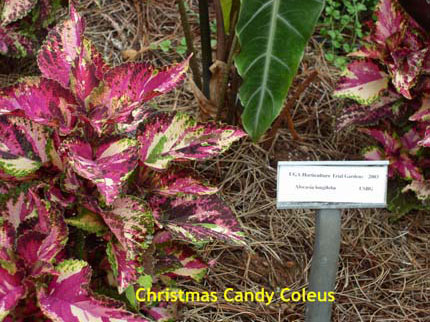Most of us gardeners have learned patience through our plant endeavors. Some of us even enjoy being teased for weeks by the swelling buds of something soon to be magnificent, but only lasting days. But sometimes, let’s admit it, we want the instantaneous ratification of instant non-stop color…just add water and presto! I do enjoy creating instant curbside appeal with colors so bright “I gotta wear shades”!
 In my landscape, I have my designated annual beds where I concentrate on bold color masses. Though there are many beautiful annual summer blooming flowers, Coleus (Solenostemon scutellarioides), by far, is my absolute favorite! I don’t have to wait for flowers because the color is all in the leaves! With its various textures and colors ranging from purple, red, orange, hot pink, chartreuse, yellow to soft pastels, there are so many possibilities. I have beautiful color from spring to frost with minimal upkeep!
In my landscape, I have my designated annual beds where I concentrate on bold color masses. Though there are many beautiful annual summer blooming flowers, Coleus (Solenostemon scutellarioides), by far, is my absolute favorite! I don’t have to wait for flowers because the color is all in the leaves! With its various textures and colors ranging from purple, red, orange, hot pink, chartreuse, yellow to soft pastels, there are so many possibilities. I have beautiful color from spring to frost with minimal upkeep!
Native to Eastern Asia and Malaysia, coleus has become naturalized in many tropical settings such as Hawaii, Fiji, and the Cook Islands. In the mid 1800’s, Dutch traders introduced the plant to Europe and the plant breeders quickly began to hybridize new, more colorful cultivars. This soon caught the eye of British and American gardeners as well. Coleus is a member of the mint family, Lamiaceae. Don’t be frightened! Unlike true mints (Mentha spp.), coleus does not have runners and cannot survive our Georgia winter temperatures. As soon as first frost comes, it’s history.
I’ve also found that coleus is not just for shade. There are many wonderful cultivars that can handle full sun! Special thanks to Dr. Allan Armitage of the University of Georgia for introducing many of these new cultivars that thrive and stay bright-colored in our southern sun! In fact many of the cultivars that are said to prefer shade, can handle the sun. They just fade to a lighter color usually more yellow or golden) in full sun. They will also require more frequent watering.
 Be sure to group your annual coleus in masses rather than spotty hit n’ miss plantings. Not only will this have the most impact, but also they will be far easier to care for. To achieve this impact, have designated annual beds. Annual beds look best when the soil is mounded about six to ten inches above ground level. When dealing with an area of poor red clay soil, first till up the area about 2 or 3 inches deep. Then mix approximately 2-parts soil conditioner, 1-part mushroom compost, and 1-part topsoil in your wheelbarrow. dd this mix to the existing soil and till again. Then with a shovel and rake, work the area into a nice mound. At this point, add a slow release fertilizer (such as Osmocote) and water saving crystals (mix according to label) mixing in about three to six inches deep. Then mark the planting holes with your trowel (spacing will depend of cultivar) about six to twelve inches apart and three to four inches deep. Prior to planting, thoroughly water the soil and the individual plants. Now the area is ready to pop the plants in. If the plants look a little root bound, gently pull the root ball apart with your fingers while placing in the hole. Now tuck the soil around the plant eliminating air pockets. To help retain moisture and eliminate weeds, place a thin layer (one half to one inch) of pine bark mini-chips around the plants. Then cleanup the plants with one last misting of water.
Be sure to group your annual coleus in masses rather than spotty hit n’ miss plantings. Not only will this have the most impact, but also they will be far easier to care for. To achieve this impact, have designated annual beds. Annual beds look best when the soil is mounded about six to ten inches above ground level. When dealing with an area of poor red clay soil, first till up the area about 2 or 3 inches deep. Then mix approximately 2-parts soil conditioner, 1-part mushroom compost, and 1-part topsoil in your wheelbarrow. dd this mix to the existing soil and till again. Then with a shovel and rake, work the area into a nice mound. At this point, add a slow release fertilizer (such as Osmocote) and water saving crystals (mix according to label) mixing in about three to six inches deep. Then mark the planting holes with your trowel (spacing will depend of cultivar) about six to twelve inches apart and three to four inches deep. Prior to planting, thoroughly water the soil and the individual plants. Now the area is ready to pop the plants in. If the plants look a little root bound, gently pull the root ball apart with your fingers while placing in the hole. Now tuck the soil around the plant eliminating air pockets. To help retain moisture and eliminate weeds, place a thin layer (one half to one inch) of pine bark mini-chips around the plants. Then cleanup the plants with one last misting of water.
There’s no guessing as when to water next. Coleus will do the droopy dance when it gets thirsty. Just water and within a couple of hours they’re perked up again. My coleus beds that are in full sun and next to the street require two thorough watering per week in he summer (if it hasn’t rained). Other than watering, I pinch off the upper third of the plant (about three to four times a season), to keep it from getting leggy and flowering. Yes, this is one plant that you want to pinch off the flower buds. If you decide to let it loom, they do attract all sorts of great pollinators.
 To keep the color alive, many gardeners collect root cuttings in fall. It’s easily propagated by taking four inch cuttings of healthy Plants just prior to first frost. Using a sharp clean knife, cut just below the leaf node at an angle. Remove the lower leaves (keeping he top two to four leaves) and submerse about one to two inches of the stem in water. Place the cuttings in a sunny window and be sure to change the water a couple of times a week. Within two weeks, you’ll see roots developing. They are then ready to transplant into a container with good, well drained, sterile potting medium. Keep inside until last frost has passed and ground temperature has armed up to at least 50 degrees F. The cuttings also can be rooted directly in soil. For this, use two to four inch cuttings, removing ll leaves except the top two. Place the stem about one inch deep into moist soil (you can dip first into a rooting hormone such as Roottone). Again, be sure that you are using a good, well-drained, sterile potting medium. Place your containers in a warm sunny window and do not allow the soil to dry out.
To keep the color alive, many gardeners collect root cuttings in fall. It’s easily propagated by taking four inch cuttings of healthy Plants just prior to first frost. Using a sharp clean knife, cut just below the leaf node at an angle. Remove the lower leaves (keeping he top two to four leaves) and submerse about one to two inches of the stem in water. Place the cuttings in a sunny window and be sure to change the water a couple of times a week. Within two weeks, you’ll see roots developing. They are then ready to transplant into a container with good, well drained, sterile potting medium. Keep inside until last frost has passed and ground temperature has armed up to at least 50 degrees F. The cuttings also can be rooted directly in soil. For this, use two to four inch cuttings, removing ll leaves except the top two. Place the stem about one inch deep into moist soil (you can dip first into a rooting hormone such as Roottone). Again, be sure that you are using a good, well-drained, sterile potting medium. Place your containers in a warm sunny window and do not allow the soil to dry out.
Through my various research of coleus, I was actually surprised to see how many cultivars of coleus existed. I had found there to be 922 listed cultivars! There are variations in color, size, form, and leaf shape. There are forms that are tall and thin to short ground covers to full mounds; leaves that are scalloped to twisted, to lacy; and colors of the rainbow that are solid to speckled, to striped.
Just in case you can’t find the variation you desire with coleus alone, there are many other annual companion plants to choose from. For plantings in full sun, low growing verbena is a nice accent around the base of your beds. Other sun loving annuals that do well with coleus are Ageratum, Pentas, and Zinnia. In shade, use Persian shield (Strobilanthes dyerianus), Impatiens, and Caladiums. If you
choose to place your coleus in a container, be sure to use a large container at least twelve inches in diameter. Add sweet potato vine at the base of the coleus to fall over the edge of the container.
Now put on your shades and get ready for a blast of summer color!
Sidebar:
The following websites were a great resource of information:
Coleus Finder has wonderful images and will help with locating a nursery: http://www.coleusfinder.org
Glasshouse Works also has a great library & catalog: http://www.rareplants.com/gallery2.html
QUICK FACTS
Common Name: Coleus or Painted Nettle
Botanical Name: Solenostemon scutellarioides
Native Range: Eastern Asia and Malaysia
Cold hardiness: Will not survive frost.
Color: varies from soft pastels to vivid pink, purple, red, orange, yellow, chartreuse, green.
Blooming Period: A mint-like flower stalk usually purple.
Type: Annual
Size: Varies from six inches to four feet.
Exposure: Full sun to shade
KEYS TO SUCCESS
When to Plant: After last frost and soil temps warmed to at least 50 deg. F.
How to Plant: Raised bed of six to ten inches well-amended soil.
Spacing: Six to twelve inches depending on cultivar.
Soil: Acid, rich organic, moist.
Watering: About two times per week or when top one to two inches of soil is dry.
When to Prune: Pinch off approximately one-third of plant when flower stalk appears.
When to Fertilize: Use slow release fertilizer at time of planting.
Suggestions for Your Landscape: Plant in masses of at least one foot wide by six feet long.
